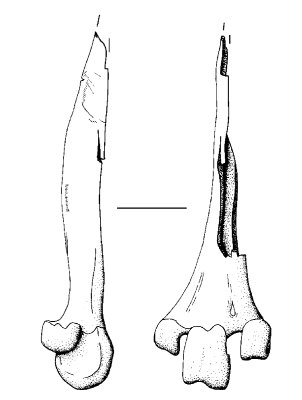Animal Bone from TP, BACH1 and West
From Archive ReportsWork on the identification of animal bones from the TP, BACH1 and West areas continued to enhance the sample previously recorded material.
The studied bone material from TP, primarily late in date, Byzantine and Chalcolithic, revealed interesting marks of burning, gnawing, weathering, digestion, fragmentation as well as bone pathology. Sheep/Goat are the most common species, forming 17% of the analyzed assemblage, followed by cattle, horse and dog.
A very interesting sheep skull was found in unit 7016. Two small blades were stabbed symmetrically into the frontal part of this well-preserved skull. The stabbing tools were made either of bone or stone but an exact attribution of the material remains unknown at this stage of analysis.
Other discoveries from TP are dog footmarks found in a mudbrick. The brick was part of marker construction of one of the Byzantine burials (Figure 7). There are two footmarks with five toes each and one is located on top of the other. These are certainly dog footmarks, made when the brick was newly formed and the clay soft enough.
In the Neolithic assemblage from the BACH1 area, particularly interesting specimens were the identification of only the second bird bone from Çatalhöyük which had been worked into a point and part of a wolf humerus was also found.
 Figure 18: 8178.F55 - bone point made from the tarso-metatarsus of a crane |
The raw material used for the manufacture of the bird bone point (Figure 18) was the lower portion of a tarso-metatarsus from a crane. The only previous point made from bird bone found at Çatalhöyük was also made on the same part of the skeleton of a bird of the same species and was found in an earlier level of the site. |
Positive identification for the presence of wolves was based on the distal articulation of a humerus. This specimen was from a young animal since the plate of cartilage that separates the bone shaft from the articular end and allows the growth of the bone had not ossified. Only the lower portion of the unfused bone was recovered but the size of specimen was so large that it had to have originated from a wolf rather than being remains from the relatively frequently encountered domestic dog.
Preliminary analysis of the Chalcolithic faunal remains from the West mound suggests that the assemblage is dominated by sheep and goat (91% of the identifiable bones) to a far greater extent than that from the Neolithic East Mound. The next most common species are cattle (5%) and equids (2%). Dog, pig, roe deer and a larger cervid (probably red deer) are also present. Although a focus on a few domestic species is consistent with models for the Chalcolithic, such a predominance of sheep and goat is unusual even for this.
The rare animals also raise some important points. Two of the equid bones appear to be Equus caballus, suggesting that the true horse, previously unknown on the Anatolian Plateau before the Bronze Age, was present in the Neolithic and Chalcolithic. The wild boar, which was present in decreasing quantities through the Neolithic, was either no longer present or not hunted.